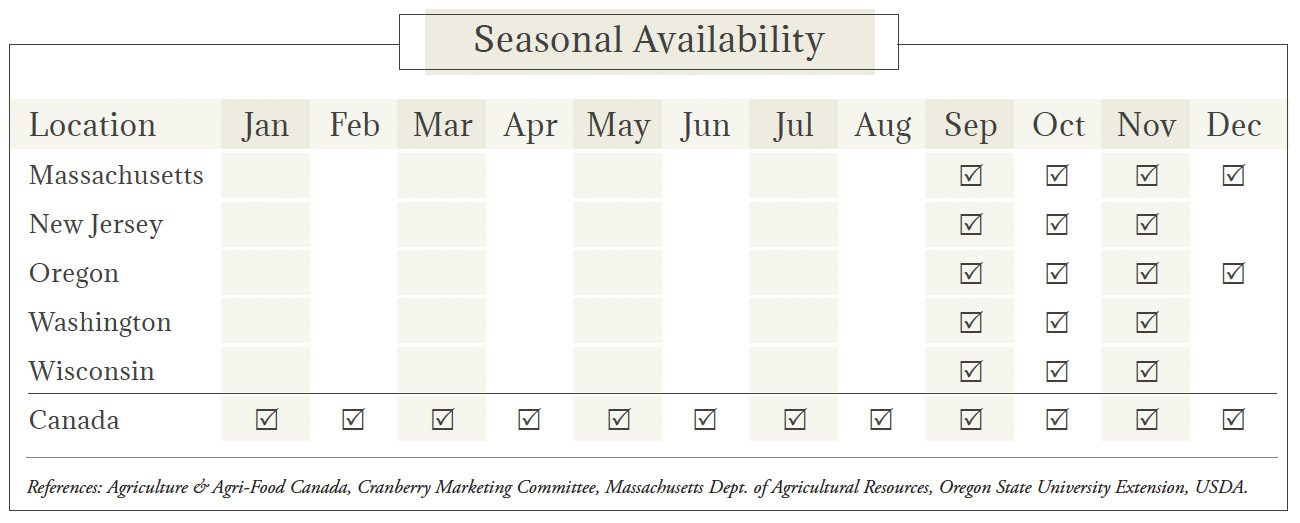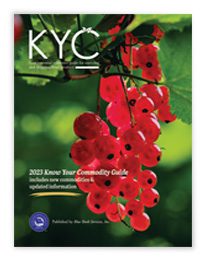Cranberry Market Summary


Image: Tim UR/Shutterstock.com
Cranberry Industry Overview
Bright red, glossy, and tart, cranberries are also known as cowberries, mossberries, foxberries, lingonberries, and bounceberries (because ripened berries will bounce due to air pockets in the fruit).Indigenous to the United States, cranberries were a pivotal part of Native American diets and lauded for their nutritional and medicinal qualities. Today, cranberries are consumed fresh or dried in salads, snacks, syrups, and beverages, and as the highly popular cranberry sauce.
Types & Varieties of Cranberries
Cranberries (Vaccinium macrocarpon) are native to the northeastern United States. Part of the Ericaceae family, which includes blueberries, they are a woody perennial divided into two principal types: North American and European.Commercial production in the United States comes predominantly from Wisconsin, Massachusetts, New Jersey, Oregon, and Washington, though Michigan, Minnesota, New York, and Rhode Island also grow the tart fruit. In Canada, both British
Columbia and Quebec are major commercial producers.
There are more than 100 cranberry varieties including Alfredo Compact, Baily Compact, Ben Lear, Bergman, Compactum, Crowley, Early Black, Howes, McFarlin, Pilgrim, Redwing, Searles, Stevens, and Wentworth.
Cultivation of Cranberries
Cranberries grow on a roughly 16-month cycle from bud to ripening on thick, vine-laden perennial shrub-like plants. Buds are generally planted in July, a pink flower emerges in spring, followed by small, hard green berries that ultimately ripen to red in the fall.The berries require very moist sandy soil with high organic content and ample sun; most commercial growing operations are in marshes and bogs. Once ripe, cranberries for processing are machine harvested from flooded fields allowing the berries to float to the surface for collection. Berries for the fresh market are carefully raked or combed from dry bed plants, with no flooding used in harvest.
Pests & Diseases Affecting Cranberries
The cranberry fruitworm lays eggs on unripe, green berries. Once hatched, they feed from July to September, hollowing out fruit. Berries exhibit a deflated, wrinkly, brownish appearance rather like raisins. Other damaging worms range from tipworms and armyworms to fireworms and blossomworms. Gypsy moths and flea beetles can be problematic as well.Cranberry weevils are hard to detect and will ‘play dead’ by pulling in their legs and falling to the ground for periods of time. A single female can lay up to 50 eggs; larvae will then begin
consuming flowers.
Upright dieback can be caused by fungi and infect a few runners to all plants in a given area. Typically caused by weather-related stress, it emerges after the winter flood is withdrawn, in late June or early July, or towards the end of the season in late August and September.
Fruit rot, including black, ripe, bitter, end, root, and blotch rot affect cranberries. It can be weather-induced or caused by vine growth density and poor drainage. Other diseases that can damage cranberries are fairy ring, blight, red leaf spot, cottonball, and berry speckle.
Storage & Packaging of Cranberries
Hand-harvested cranberries generally exhibit less fungal decay and physiological breakdown than water-harvested berries.
Once harvested, berries are stored between 35 to 41°F and susceptible to water loss and shriveling, so 90 and 95% relative humidity is recommended.
Though cranberries are generally immune to injury from water or ice, if exposed to temperatures below 37°F, they can suffer chilling injury including dullness, a ‘rubbery’ texture to the fruit, and a higher incidence of decay.
References: Agriculture & Agri-Food Canada, Cranberry Institute, Cranberry Marketing Committee, University of Maine Extension, University of Massachusetts Extension, Wisconsin Cranberry Board, Inc.
Grades & Good Arrival of Cranberries
Generally speaking, the percentage of defects shown on a timely government inspection certificate should not exceed the percentage of allowable defects, provided: (1) transportation conditions were normal; (2) the USDA or CFIA inspection was timely; and (3) the entire lot was inspected.| U.S. Grade Standards | Days Since Shipment | % of Defects Allowed | Optimum Transit Temp. (°F) |
| 7-5 (en route) | 5 4 3 2 1 | 12-7 11-7 10-6 8-5 7-5 | 36-40° |



